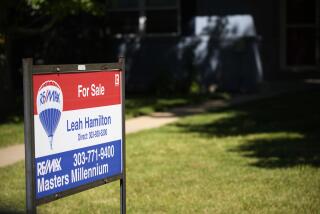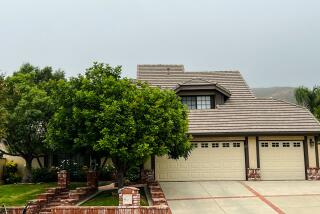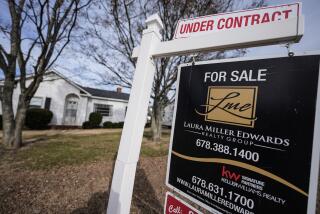The pix that get the clicks
- Share via
A picture may be worth a mere 1,000 words in other circles, but in real estate, it enters the realm of deal or no deal.
With an estimated 80% of home buyers starting their search on the Internet, photos are to home sales today what curb appeal used to be: the place where first impressions are made.
According to a National Assn. of Realtors survey of the Web features that buyers found “very useful,” 83% mentioned photos, 81% liked detailed property information and 60% named virtual tours.
Every day, decisions about which homes to see -- and which to skip -- are made based on what a buyer sees online.
“If you can’t get them in the door,” said Coldwell Banker agent Kenny Bellini of Santa Monica, “you can’t sell the house.”
Bellini and his wife, Izumi Tanaka, generally shoot their listing photos themselves, as do many other realty agents. And, as he is quick to admit, photography skills aren’t part of an agent’s training -- even though posting quality photos on the Web has now become one of the services an agent must offer clients to stay competitive.
Increasingly, agents and sellers are turning to professional photographers to do what they themselves cannot: Take those jaw-dropping glamour shots even when the home isn’t a mansion or an architectural gem. When a professional photographer is brought in, it’s most often the realty agent who pays for the service as part of the marketing plan.
The rates in Los Angeles start at about $350 and can climb steeply depending on whom you hire, how many photos are shot and whether the photographer sets up an exclusive domain website for the home.
Is there any way to get better photos, short of hiring a pro?
For an answer to that question, The Times asked three of Los Angeles’ top high-end real estate photographers for tips on how home sellers and listing agents could improve their own photos.
Santa Monica-based Nick Springett has more than 20 years’ experience shooting listings up to $70 million. His work has appeared on the covers of Unique Homes and Leading Estates of the World magazines. Among his suggestions:
* Make the room look inviting. Set the dining room table with fresh flowers, complete place settings and ironed linens.
* Leave no detail unattended. Tape the folds of the dining room tablecloth so it doesn’t pucker out. Position chairs uniformly (about 1 foot) from the table’s edge.
* When possible, use the chandelier above the table to create a warmer glow.
* Strive for even lighting. Professionals use strobe lights to brighten the dark spots. One of the mistakes that amateur photographers make is to shut all the blinds and turn on every artificial light in the room. This creates “halos” around each lamp. Don’t shoot when sunlight is streaming in from the windows. And use the flash on the camera to even things out.
* Emphasize desirable features such as fireplaces and views. De-emphasize less-desirable features such as the closeness of the house next door.
* Bring in more furniture from other rooms to avoid blank holes in the photo. Make a room look homey. Arrange books and/or magazines on the coffee table with the colorful ones on top.
* Don’t ignore the background. Remove all electrical cords from view, tidy up bookcases, fluff couch pillows. Flip the cushion over if Fido has been there, or use a throw to cover the stain.
* Wet down the brick patio and concrete pool surround to avoid it being too bright in the photo. Wetting it down also brings out the rich color in the brick.
* Remove all clutter. Also remove all personal photos. The goal is to have potential buyers envision themselves living in your house; your family’s photos interfere with that process.
* In staging a room, group similar objects together rather than leaving them scattered. Arrange books based on their size and jacket colors, not literary content; a home buyer won’t be analyzing your reading habits. Candles, flowers and coffee table art books all add character to a room and are inexpensive ways to decorate. Light the fireplace to make the room look warm and inviting.
* Shooting a pool presents special challenges because of the reflective nature of the water. Use a flash and try your shot in late afternoon or early morning.
* Consider using a software program such as Photoshop to touch things up. Springett sometimes uses it as a way to eliminate telephone and electric wires. Ditto for punching up colors and obscuring some less desirable elements.
Everett Fenton Gidley, Santa Monica -- who by his estimate has shot more than $3 billion in real estate -- adds these ideas:
* If there’s no furniture, get some. Empty houses lack soul.
* De-clutter. Remove all personal effects, especially whatever is hanging on the refrigerator.
* Underexpose rather than overexpose.
* Adobe Photoshop Elements 5.0 is a good software program for nonprofessionals. It allows color and lighting adjustments and for flaws to be fixed easily. It costs about $100. Agents, who will be using it more often, might want to invest in Adobe Photoshop, which costs about $600.
Altadena-based Chris Considine, who has shot historical homes and bungalows for the last nine years, has these recommendations:
* Use a tripod. It provides steadiness and allows you to operate your digital camera’s controls -- specifically, shooting interiors at a slower speed.
* Move excess furniture out of the way. You don’t want to be shooting directly into the backs of chairs.
* Don’t be afraid of the shade. Gardens look richer when they aren’t shot in the blazing sun.
All of this leaves homeowners who are screening potential listing agents with a new question to ponder: How will the agent handle photographing their home and presenting it on the Web?
The question is music to the ears of Topanga Pritchett-Rapf agent Gary Harryman, who knows his way around a camera and has an Internet-savvy wife, Mariline. His easy-to-navigate website is filled with dozens of high-quality photos of his listings.
“Mariline and I realized the value and the increasing importance of the Internet years ago, and adjusted our marketing accordingly,” Harryman said.
Harryman has had a lifelong interest in photography -- he had his first darkroom when he was 10 years old -- and has a master’s degree in sculpture. “I see every house as a work of art -- specifically, a sculpture. And I try to exhibit it on our website in as flattering a light as a curator does a sculpture exhibition in a museum or gallery,” he said.
His wife, who is also a real estate agent, keeps their website up-to-date. It’s not unusual for her to make changes to it several times a day.
“She is constantly updating and improving. If I get a new photograph with different light and a better angle, she will immediately put it up on our website,” Harryman said.
The effort has paid off: The Harrymans sold more than $10 million in properties in the first quarter of this year.
“It’s the website,” he said.
Interior designer Hillary Hayne listed her 4,680-square-foot Topanga home at $3,495,000 with him two weeks ago, after having seen his website (www.garyharryman.com).
“It’s easy to navigate and is a great source of information,” she said. “Plus, he’s just passionate about his photos.”
Harryman spent hours shooting her home, and the results show, Hayne said.
One feature of Harryman’s website is the full-screen slide show. The consensus is that Web viewers won’t stay with a site if they have to open and close each photo by clicking on it.
“You have to make it easy or they’ll quit on you,” photographer Gidley said. “It’s a great tool.”
Who should take the photos for a home listing remains an individual decision, but this anonymous quote offers some words of wisdom:
“Buying a Nikon doesn’t make you a photographer. It makes you a Nikon owner.”
*
*
Begin text of infobox
What the pros charge
Ready to hire the big guns? Here’s an idea what it will cost.
Nick Springett
(310) 493-5166, www.nickspringett.com
Springett charges a flat rate of $1,000 for a half-day photo shoot, which includes styling of the home and establishing an exclusive domain website for one year. The listing agent is given a disk of the photos to use for fliers and Multiple Listing Service postings.
*
Everett Fenton Gidley
(310) 393-3474, www.efg3.com/
Fees start at $500 for homes listed under $1.5 million, $750 for properties listed from $1.5 million to $2 million. Gidley shoots from 25 to 50 exposures and creates a website with a registered domain name for the seller. The website stays up for a year and includes a full-screen slideshow presentation of the photos.
*
Chris Considine
(626) 798-1617
Considine charges $120 an hour with a three-hour minimum. Most properties take four hours to shoot. Clients are given a disk of the photos. He charges $450 for a website with its own domain address that stays up for six months. It includes a 25-image slideshow.
More to Read
Inside the business of entertainment
The Wide Shot brings you news, analysis and insights on everything from streaming wars to production — and what it all means for the future.
You may occasionally receive promotional content from the Los Angeles Times.










